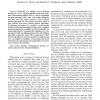208 search results - page 11 / 42 » What Helps Where - And Why |
SIGDOC
2000
ACM
14 years 2 months ago
2000
ACM
∗ DSTOP, the Design Support Tool for Operating Procedures, is a relatively simple software tool for support of designers of new interfaces and their procedures for use. DSTOP is ...
TKDE
2010
13 years 8 months ago
2010
— Tampering of a database can be detected through the use of cryptographically-strong hash functions. Subsequently-applied forensic analysis algorithms can help determine when, w...
IJMMS
2006
13 years 9 months ago
2006
Change awareness is the ability of individuals to track the asynchronous changes made to a collaborative document or graphical workspace by other participants over time. We develo...
EICS
2010
ACM
13 years 12 months ago
2010
ACM
Modern User Interfaces (UI) must deal with the increasing complexity of applications in terms of functionality as well as new properties as plasticity. The plasticity of a UI deno...
NIPS
2008
13 years 11 months ago
2008
Randomized neural networks are immortalized in this well-known AI Koan: In the days when Sussman was a novice, Minsky once came to him as he sat hacking at the PDP-6. "What a...

